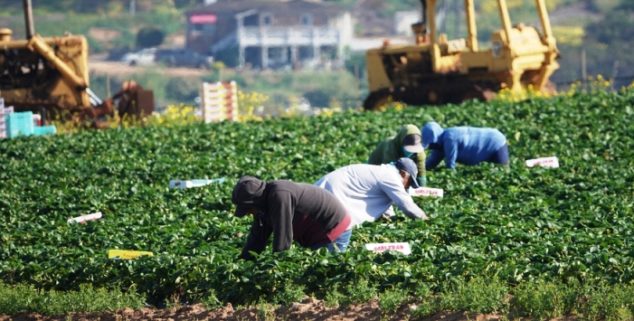News
Coronavirus devastates California farm workers
 Farm workers with masks pick strawberries near Carlsbad, San Diego County. (Photo: Simone Hogan, via Shutterstock)
Farm workers with masks pick strawberries near Carlsbad, San Diego County. (Photo: Simone Hogan, via Shutterstock)Back in April, when the lockdown was first beginning, a California Farm Bureau study reported that the agriculture sector had lost more than 2.4 million jobs directly attributable to the COVID-19 pandemic. Now, along with the financial hit, farm workers are suffering through increased risk of deadly infection.
While employment in the state overall may be stabilizing as the market adjusts to the lockdown, California’s Central Valley and its other major agricultural areas have seen their jobless rates stagnate at high levels.
“Latino Californians experienced a 36% increase in mortality, with a 59% increase among Latino food/agriculture workers.” — UCSF study
But even for those farm workers who have been able to keep their jobs, the situation is still dire.
A recent study by researchers at the University of California, San Francisco suggests the chances of agricultural workers dying has increased by more than 35% overall, and nearly 60% for Latinos.
“Certain occupational sectors have been associated with high excess mortality during the pandemic… Latino Californians experienced a 36% increase in mortality, with a 59% increase among Latino food/agriculture workers,” the study noted.
Despite the grim numbers, California farms are enduring.
“With some minor adjustments, most outside agriculture operations can minimize the person to person contact,” says Ryan Jacobsen the CEO of the Fresno County Farm Bureau, but, he added, “That becomes a much bigger problem when you start to get to processing and harvesting operations.”
The operations that can’t be socially distanced normally have an overwhelmingly Latino workforce.
Slaughterhouses were the sources of many early COVID-19 outbreaks back in April 2020. Much of the increased rate of infection can be attributed to the conditions that impoverished farmworkers face on a daily basis. The Migrant Clinicians Network noted that farm workers often must live in shared housing, frequently commute in crowded carpools and often lack access to paid sick leave.
“We were set up to distribute around 50,000 vaccines a week and right now, our allotments from the state are somewhere in the 8,000-12,000 range.” — Ryan Jacobsen
While the situation has improved as organizations such as the Fresno CFB and UFW Foundation have distributed millions of pieces of personal protective equipment to vulnerable farmworkers, there still is an ever-present increase in risk of death.
“The majority of farm workers are undocumented, and in a survey that we conducted of over 14,000 farm workers, of the individuals that responded, 78% did not have health insurance,” said Diana Torres, executive director of the UFW Foundation, and serving member on the California Community Vaccine Advisory Committee.
“It’s not rock bottom,” she added. “Farm workers are out there every day, continuing to die at very high rates. It is a very critical time to ensure that we protect these essential workers who feed the entire state.”
Agriculture workers are scheduled to receive the COVID-19 vaccine under Phase 1B of the California vaccine rollout.
But according to Jacobsen, the vaccine supply is just too small to adequately meet demand.
“We were set up to distribute around 50,000 vaccines a week and right now, our allotments from the state are somewhere in the 8,000-12,000 range.” In recent days, mass vaccination sites across the state have been forced to close down due to a lack of vaccine.
“Our communities suffer from a lack of trust in medicine, as well as a lack of access to vaccine rollout programs.” — Reginald Jones-Sawyer
But even if enough vaccines were to magically pop in to existence, there are other social and psychological barriers confronting the minority and farming communities.
“The disproportionate mortality rates amongst food and agriculture workers has been absolutely appalling,” says Assemblymember Reginald Jones-Sawyer (D-Los Angeles), who serves on the Assembly Agriculture Committee and chairs Assembly Public Safety Committee.
Latinos in particular are more vulnerable to anti-vaxx conspiracy theories and more likely to express vaccine hesitancy than their white counterparts.
“Our communities suffer from a lack of trust in medicine, as well as a lack of access to vaccine rollout programs,” he added.
While the vaccination rate in California rises, farm workers will still need to deal with the dangers of their job. Protecting them will require a concerted effort from the state government, businesses, and activists.
But a strategy that revolves simply around “make more vaccines” carries its own problems: A vaccine is useless to the person who refuses to take it.
—
Editor’s Note: James Aranguren is a Capitol Weekly intern from the University of Southern California.
Want to see more stories like this? Sign up for The Roundup, the free daily newsletter about California politics from the editors of Capitol Weekly. Stay up to date on the news you need to know.
Sign up below, then look for a confirmation email in your inbox.

Leave a Reply